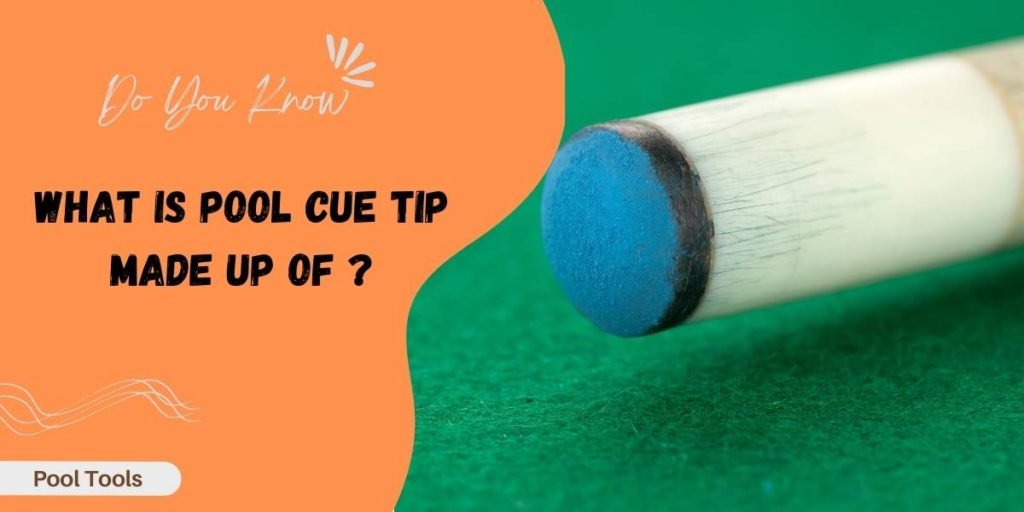What is a pool cue tip? How does it work? And why should I care?
If you’ve ever played pool or billiards, you probably already know that a pool cue has a tip at the end of its shaft. While we all know that the high-quality shafts are a mix of wood and steel, assessing the cue tip material is also essential to determine the overall quality of the cue.
| The majority of Pool Cue Tips are made up of Leather. Hard leather is pressed substantially and is further compressed. The professionals also consider Phenolic tips made out of carbon fiber as they are capable of transmitting the highest energy. |
What is Pool Cue Tip Made Up of?
Tips of the pool cue are fixed onto the white ferrule of the cue (billiard stick) and come into direct contact with the ball. Tips are chalked during the game to prevent the cue from sliding and ensure maximum impact. The cue tips are generally composed of leather. The leather is compressed, and the fibers are compressed in accordance. The vegetable-tanned leather was utilized to make tips for pool cues.
The tip is then glued to the cue, and the overhang is turned with a lathe, rounded in the front, and then sanded using the highest quality abrasive paper to ensure that the tip is in a straight line with the ferrule. The leather is then sealed with a seal on the outside edges.
Making of Pool Cue Tip
As cue tip is the only part on your pool cue that comes in direct contact with the cue ball, it is important to maintain the pool cue tip to get the perfect shots. While browsing through internet, i found this detailed video on maintaining your pool cue tip to keep them perfectly straight
Also Read: What Color Is The Cue Ball In Pool?
While playing pool, billiards, or snooker, the edge is chalked repeatedly to prevent falling on the ball. In time the surface of the material “glazes”. The constant friction causes the leather’s tip to become firm and smooth. If the tip is too smooth, chalk will no longer stick to the point.
There are a variety of methods to allow the tip to be receptive. One option involves roughening the tips using small needles. The fibre structure that is compressed in the leather gets perforated and loosens. In other words, the edge is smoothed. It decreases the thickness of the leather since the leather fibres are eliminated.
You May Like To Read: What is Hybrid Pool Cue?
Is Pool Cue Tip Material Only Made from Leather?
| Yes! In most cases, the Pool Cue tip is made from leather. But there are a few exceptions as well. |
Today’s pool cue tips are available in various materials depending on their purpose. The most popular material used for cue tips is leather. The producer usually employs the leather in different layers. They refer to them as laminated tips. Various tips are available, including cowhide, pig skin and the borehide, based on the manufacturer and the tip model.
Most of the time, they use layering of the material. The layering assists in supporting the toughness of the tip and also helps to maintain its shape. Every manufacturer could employ different methods to glue the layers.
Certain manufacturers may say their method is superior to others for some reason. Most of the time, the most contemporary laminated cue tips for leather are comparable in their construction. However, there are some variations with regard to the performance of the material and the construction.
Certain tips that are special, particularly those used to break or jump, could be made from other materials that are much stronger. Tips made of Bakelite or any other phenolic tips that are not made of leather might be as strong as the ball you’re hitting, which reduces the ball in a straight line and can transfer the maximum force to the ball and need little to there is no maintenance.
Break cues that are specifically designed and jump cues could be included with these tips. Local pool halls, tournaments, or leagues limit non-leather, phenolic tips from being employed. It is recommended to check with them before purchasing to make sure.
Conclusion:<H2>
Leather is still the best material for making cue tips. However, if you want to play with a new technology or have a unique design, it would be wise to consider the use of alternative materials. Pool players should always keep an eye out for the latest technologies and innovations when choosing their equipment.

